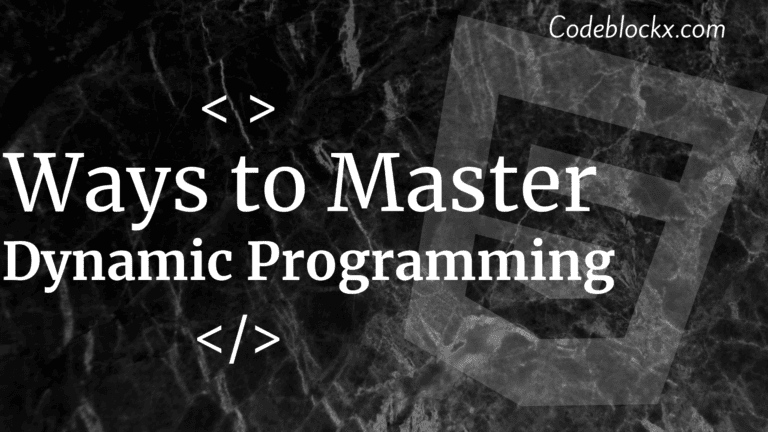Dynamic programming is a practical algorithmic approach that lets you quickly remedy complicated computational issues. It is extensively utilized in diverse pc technological know-how, economics, mathematics, and biology fields.
However, studying dynamic programming may be frightening for many novices. That’s where this step-through-step manual comes in. Whether you are a newbie seeking to commence with dynamic programming or a skilled programmer seeking to sharpen your skills, this manual has something for everyone. In this complete manual, we can cowl all you want to realize about studying dynamic programming.

Benefits of studying Dynamic Programming
Dynamic programming is a famous approach for fixing optimization issues. The advantages of studying dynamic programming are several and include the following: Dynamic programming is a problem-fixing method utilized in laptop technology and mathematics. Learning dynamic programming has several advantages, consisting of:
Improved problem-fixing abilities: Dynamic programming is a modern method that may be implemented for various problems, assisting college students in broadening sturdy problem-fixing skills that may be implemented in many exclusive domains.
Efficient algorithms: Dynamic programming algorithms are regularly extra green than different algorithms for fixing positive kinds of problems. Studying dynamic programming can assist college students in broadening algorithms optimized for pace and efficiency.
Optimization: Dynamic programming is an effective method for fixing optimization problems, which might be ubiquitous in many regions of technology and engineering. Studying dynamic programming can assist college students in broadening optimization strategies that may be used in many exclusive applications.
Better knowledge of algorithms: Dynamic programming is an essential subject within the look at algorithms, and knowledge of dynamic programming can assist college students in broadening a more profound understanding of different algorithms.
Preparation for interviews: Dynamic programming is a not unusual place subject matter in technical interviews for software program engineering and statistics technology roles. Studying dynamic programming can assist college students in putting together those interviews and enhance their possibilities of touchdown activity in those fields.
Applications in device mastering: Dynamic programming is utilized in numerous regions of device mastering, consisting of reinforcement and deep mastering. Studying dynamic programming can assist college students higher recognize those strategies and following them to real-international problems.
Analyzing dynamic programming has several advantages for college kids interested in laptop technology, mathematics, and associated fields. Dynamic programming is an effective problem-fixing method that can assist college students in broadening sturdy problem-fixing abilities, green algorithms, optimization strategies, and a higher knowledge of algorithms.
- Ability to remedy complicated computational issues
- Improved trouble-fixing skills
- Increased performance in coding
- Enhanced analytical and logical reasoning skills
- Ability to optimize algorithms for progressed overall performance
- Improved knowledge of pc technological know-how principles
By studying dynamic programming, you can address various issues in diverse fields. You’ll gain a more profound knowledge of the underlying principles and be capable of following them to real-global scenarios.

Understanding the Fundamentals of Dynamic Programming
Before diving into dynamic programming, having an excellent knowledge of the fundamentals is critical. At its core, dynamic programming is a method for fixing issues by breaking them down into smaller subproblems. It is primarily based on the precept of “choicest substructure,” meaning that the choicest way to trouble may be received through combining the most preferred answers to its smaller subproblems.
Dynamic programming is a practical hassle-fixing approach utilized in pc technological know-how and mathematics. At an excessive level, dynamic programming includes breaking a hassle into smaller subproblems and immediately fixing every subproblem. The answers to the subproblems are then mixed to resolve the unique hassle.
The key concept behind dynamic programming is that a few issues may be solved more effectively by fixing smaller subproblems and reusing their answers. This is specifically real while fixing optimization issues, in which the solution to the hassle includes locating the most desirable technique to a sequence of subproblems. The three essential standards of dynamic programming are:
Overlapping subproblems: Dynamic programming issues contain breaking a hassle down into smaller subproblems. Those subproblems often overlap, meaning that fixing the identical subproblem in more than one instance is wasteful. Dynamic programming strategies’ goal is to resolve every subproblem most effectively as soon as and reuse the answer while needed.
Optimal substructure: Dynamic programming issues contain locating the most desirable technique to a hassle by finding the most desirable approach to a sequence of smaller subproblems. The most desirable method to the nuisance may be made from the most desirable answers to the subproblems.
Memoization: Memoization is used in dynamic programming to keep the effects of solved subproblems in reminiscence. By doing so, this system can reuse the answers to the subproblems instead of recalculating them.
Dynamic Programming
To use dynamic programming to resolve a hassle, the hassle should have the most desirable substructure and overlapping subproblems. Once those situations are met, the nuisance may be solved by breaking it down into smaller subproblems, fixing every subproblem as soon as possible, and storing the answers to the subproblems in reminiscence for later reuse.
Dynamic programming is a practical hassle-fixing approach that includes breaking a hassle down into smaller subproblems, fixing every subproblem immediately, and reusing the answers to the subproblems. Understanding dynamic programming basics is critical for effectively improving complicated optimization issues.
One of the essential principles in dynamic programming is memoization, a method for storing the effects of highly-priced characteristic calls and returning the cached result while the equal inputs arise again. This can extensively enhance the overall performance of dynamic programming algorithms.

Identifying Issues Appropriate for Dynamic Programming
Not all issues may be solved by the usage of dynamic programming. So, how do you discover issues appropriate for dynamic programming? There are some key traits to appearance:
The trouble may be damaged down into smaller subproblems.
- The choicest way to the trouble may be received through combining the most preferred answers to its subproblems.
- The trouble well-known shows overlapping subproblems, which means that the equal subproblem is solved several times.
- By figuring out issues that meet those criteria, you will be capable of effectively following dynamic programming strategies.
- Approaching dynamic programming troubles systematically
- Solving dynamic programming troubles calls for a scientific technique. Here are the critical thing steps to follow:
- Define the trouble and smash it down into smaller subproblems.
- Identify the bottom case(s) and outline the recurrence relation.
- Determine the order in wherein subproblems have to be solved.
- Implement the answer with the use of memoization or tabulation.
- Analyze the time and area complexity of the answer and optimize if necessary.
By following this systematic technique, you’ll be capable of remedying emotional programming troubles correctly and effectively.
Mastering not unusual place dynamic programming algorithms
There are numerous not unusual place dynamic programming algorithms that you have to be acquainted with. These include:
- Fibonacci sequence
- Longest, not unusual place subsequence
- Knapsack trouble
- Matrix chain multiplication
- Coin extra de trouble
You can practice dynamic programming strategies for various troubles by getting to know those algorithms.
Tips for Optimizing Dynamic Programming Answers
Optimizing dynamic programming answers may be challenging. However, there are some suggestions that can help:
- Use memoization to keep away from redundant calculations.
- Use tabulation whilst memoization is only sometimes feasible.
- Optimize the recurrence of family members to lessen the wide variety of subproblems.
- Use information systems inclusive of arrays and matrices to shop subproblem answers.
- Analyze the time and area complexity of the answer and optimize if necessary.
- Imposing those suggestions lets you optimize your dynamic programming answers for stepped-forward performance.
Dynamic programming demands situations and a way to triumph over them.
While dynamic programming is an effective method, there are a few demanding situations that you can encounter. One of the essential challenging situations is figuring out the most desirable substructure of trouble. This calls for a deep knowledge of the problem and its underlying structure.
Another undertaking is managing massive entry sizes that can cause reminiscence and time constraints. To conquer this, you may use optimization strategies inclusive of pruning and approximation.
Finally, dynamic programming may take a lot of work to implement correctly. To avoid errors, you must check your answer very well and debug any troubles that arise.

Resources for Gaining knowledge of and Training Dynamic Programming
There are numerous sources to gain knowledge of and training in dynamic programming. Some of the excellent sources include:
- Online publications inclusive of Coursera’s “Algorithmic Toolbox” and MIT’s “Introduction to Algorithms.”
- Books inclusive of “Introduction to Algorithms” with the aid of using Cormen, Leiserson, Rivest, and Stein.
- Practice websites inclusive of LeetCode and HackerRank.
- Dynamic programming blogs and forums, inclusive of GeeksforGeeks and Reddit’s r/dpforbeginners
Using those sources, you will be capable of deepening your knowledge of dynamic programming and exercising your talents on a massive variety of troubles.
Conclusion
Dynamic programming is an effective method for fixing complicated computational troubles. By getting to know this method, you can address many problems in diverse fields. In this complete manual, we blanketed the fundamentals of dynamic programming, how to discover concerns appropriate for dynamic programming, and how to systematically technique dynamic programming troubles. We additionally covered a few not-unusual places for dynamic programming algorithms, suggestions for optimizing active programming answers, and triumphing over dynamic programming demanding situations.
Finally, we highlighted a few sources for gaining knowledge and training in dynamic programming. With practical examples, real-global applications, and professional suggestions and tricks, you can take your programming talents to the following degree with this complete manual to get to know dynamic programming.